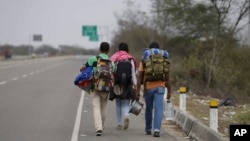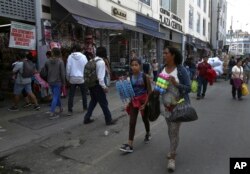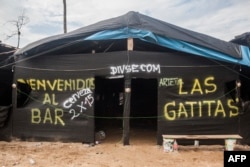Migrant children fleeing alone from Venezuela's economic and political crises, along with destitute Venezuelan migrants arriving without documents both make easy prey for human traffickers in Peru, anti-slavery experts said Tuesday.
About one in 10 Venezuelans — 3.4 million people — have fled their homeland in recent years.
After Colombia, Peru is home to the second-largest number of Venezuelan migrants, with more than a half a million having settled there, searching for food and a better life.
From 2017 to 2018, authorities in Peru recorded more than 1,700 victims of human trafficking, of which about 10 percent were Venezuelan, said Jose Ivan Davalos, head of mission for the U.N.'s International Organization for Migration (IOM) in Peru.
"This figure could increase because of the vulnerable condition in which this population [of migrants] arrives in the country," Davalos said in the capital Lima during an anti-trafficking event.
"Many people who arrive, they arrive without documentation, without being able to identify themselves, and above all, boys and girls who are not accompanied arrive, and they can be easily recruited [by traffickers]," said Davalos at the event that brought regional governors and officials together.
He added that, on average, about two victims of trafficking are reported every day in Peru.
Poor and hungry teenage girls and women are most likely to become victims of sex trafficking, experts said.
Lured by false offers of free travel and well-paid work as waitresses, dancers or cooks in mining areas, migrants can end up forced into prostitution and made to work to pay off their debts, according to prosecutors. In Peru's Amazon jungle area of Madre de Dios, the heart of illegal gold mining, there are dozens of bars and brothels used by miners.
In the past year, raids by police in Madre de Dios — also known as a hot spot of sex trafficking — have led to the rescue of Venezuelan women and girls being sexually exploited.
Alejandro Delgado, an official at Peru's interior ministry, said combating "the scourge" of human trafficking requires local and national authorities and countries in the region working together.
"It's a phenomena that we can't tolerate, we can't allow that people, above all women and girls, to be treated as objects. It's inhumane," said Delgado, who heads a commission against human trafficking and illegal migrant smuggling.
Peru's "porous borders," including those with Ecuador and Bolivia, allow traffickers and their victims to move around with ease, Marisol Perez, a former justice minister said.
"We don't have the capacity to control our borders," she said.







